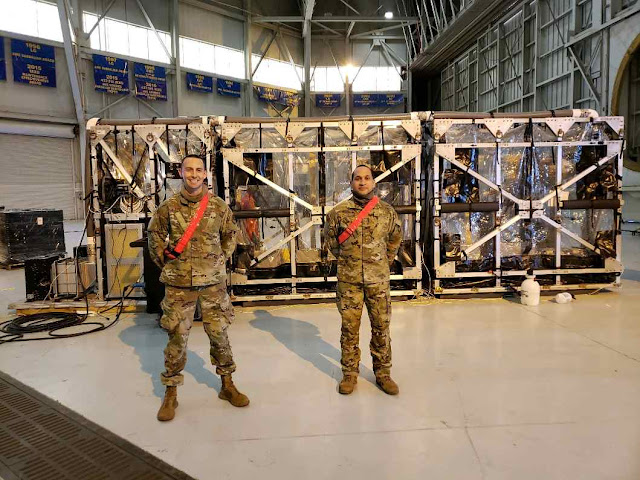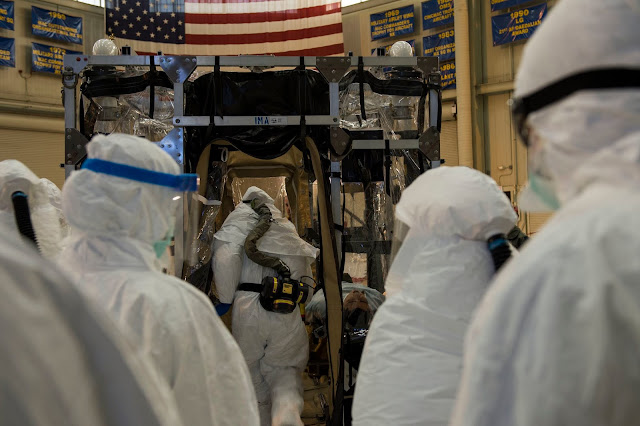USU Alumni Train, Staff Critical Care, Isolation Transport Teams
By Zachary Willis
As COVID-19 continues its worldwide spread, military medical service members are taking on unprecedented challenges. One challenge in particular has required incredibly quick thinking and the ability to adapt previous technology for this new mission. Maj. (Dr.) Daniel Adams, an Air Force pediatric infectious disease physician and Uniformed Services University alumnus, is serving as a member of a Transport Isolation System (TIS) team caring for COVID-19 patients in air transportable isolation chambers loaded on C-17 aircraft.
Originally developed as a way to safely move patients infected with Ebola back to the United States for healthcare during the 2014 outbreak in West Africa, the TIS now serves a new purpose transporting COVID-19 patients safely while protecting the aircraft crew.
“It’s like a flying negative pressure room,” Adams says about the TIS. “It allows for isolation and care of infected patients and has a space for healthcare workers to take off their personal protective equipment and exit into the aircraft without bringing the virus with them.”
In early March, Adams was in Charleston training to move Ebola patients in the TIS, but COVID-19 was quickly spreading, and discussion was taking place about whether the TIS would be used. Sure enough, three weeks later the U.S. Transportation Command tasked the Air Force’s Air Mobility Command (AMC) with the job of adapting the TIS for use with the novel coronavirus, and Adams was deployed to Joint Base Charleston to train others and move infected patients.
“AMC had to write a new manual for the TIS, create new training, and bring in staff to develop these TIS teams to fly on the C-17,” Adams says.
Each TIS team, Adams elaborates, is made up of 16 crew, including technical experts who know how to use the TIS systems, such as biomedical engineers and biotechnicians, a Critical Care Air Transport team, and an aeromedical evacuation (AE) team. Lastly, there is an infectious disease (ID) team of which Adams is a member.
“The ID team’s job is to monitor everyone who is going in and out of the TIS,” Adams says. “We give instructions to staff on what order to take their equipment off in, and the proper technique. We handle any breaches or any exposures, and advise the medical crew director on any measures that the pilots or crew members outside the TIS should take if there’s a breach.”
Adams also says the mission has been a USU reunion, with several alumni working on various teams to provide care. Maj. (Dr.) Stuart Wood, class of 2008, and Maj. (Dr.) Shane Patterson, class of 2012 also serve as ID team leads, like Adams. Maj. (Dr.) Joshua Gustafson, class of 2009, and Maj. (Dr.) Owen Scott, class of 2009 both serve as CCAT team leads on their respective TIS teams.
TIS teams have been pre-positioned around the world to take COVID-19 patients in need to the closest areas of safety, and several successful missions have evacuated COVID-19 patients to Landstuhl Regional Medical Center in Germany.
The challenge, Adams says, comes from the nature of providing care on a C-17 aircraft for patients with constantly shifting needs. The CCAT and AE teams are trained to anticipate the changes that the patient may face, such as oxygen needing to be hooked up to the TIS and ready to go in case the patient’s condition starts to worsen en route. These ever-changing factors contribute to the processes the teams are creating, and the equipment they’re bringing.
“It’s been tough because we’re training and developing procedures for a system to control the spread of a pathogen we’re still learning about,” Adams says. “The data is coming out as they’re doing these studies, and we’re having to change procedures quickly.”
But what steps are the crew taking to stay safe in the presence of COVID-19? Adams says that the Air Force has provided the teams with all the appropriate personal protective equipment they need to give care in the air, including Powered Air-Purifying Respirators, which are worn by those who are taking patients on and off the aircraft and performing higher risk activities such as intubating. With that in mind, every mission’s results ultimately inform the safety procedures of future missions for how the aircraft’s crew will be protected inside and outside of the TIS.
Despite the challenge, Adams is excited to see the TIS used for real-world missions after years of time and effort spent developing the system, and is thankful to be part of a mission that provides worldwide care.
“It’s certainly astounding to me the lengths to which we’re willing to go to move these patients,” Adams says. “I’m proud to be a member of the Military Health System, and particularly the U.S. Air Force, that clearly cares so much for the welfare of its people, our service members, and all U.S. citizens.”
As COVID-19 continues its worldwide spread, military medical service members are taking on unprecedented challenges. One challenge in particular has required incredibly quick thinking and the ability to adapt previous technology for this new mission. Maj. (Dr.) Daniel Adams, an Air Force pediatric infectious disease physician and Uniformed Services University alumnus, is serving as a member of a Transport Isolation System (TIS) team caring for COVID-19 patients in air transportable isolation chambers loaded on C-17 aircraft.
Originally developed as a way to safely move patients infected with Ebola back to the United States for healthcare during the 2014 outbreak in West Africa, the TIS now serves a new purpose transporting COVID-19 patients safely while protecting the aircraft crew.
“It’s like a flying negative pressure room,” Adams says about the TIS. “It allows for isolation and care of infected patients and has a space for healthcare workers to take off their personal protective equipment and exit into the aircraft without bringing the virus with them.”
In early March, Adams was in Charleston training to move Ebola patients in the TIS, but COVID-19 was quickly spreading, and discussion was taking place about whether the TIS would be used. Sure enough, three weeks later the U.S. Transportation Command tasked the Air Force’s Air Mobility Command (AMC) with the job of adapting the TIS for use with the novel coronavirus, and Adams was deployed to Joint Base Charleston to train others and move infected patients.
 |
| Air Force Maj. (Dr.) Daniel Adams (left) is among a number of USU alumni training or staffing Transport Isolation System teams. (Courtesy photo) |
“AMC had to write a new manual for the TIS, create new training, and bring in staff to develop these TIS teams to fly on the C-17,” Adams says.
Each TIS team, Adams elaborates, is made up of 16 crew, including technical experts who know how to use the TIS systems, such as biomedical engineers and biotechnicians, a Critical Care Air Transport team, and an aeromedical evacuation (AE) team. Lastly, there is an infectious disease (ID) team of which Adams is a member.
“The ID team’s job is to monitor everyone who is going in and out of the TIS,” Adams says. “We give instructions to staff on what order to take their equipment off in, and the proper technique. We handle any breaches or any exposures, and advise the medical crew director on any measures that the pilots or crew members outside the TIS should take if there’s a breach.”
Adams also says the mission has been a USU reunion, with several alumni working on various teams to provide care. Maj. (Dr.) Stuart Wood, class of 2008, and Maj. (Dr.) Shane Patterson, class of 2012 also serve as ID team leads, like Adams. Maj. (Dr.) Joshua Gustafson, class of 2009, and Maj. (Dr.) Owen Scott, class of 2009 both serve as CCAT team leads on their respective TIS teams.
TIS teams have been pre-positioned around the world to take COVID-19 patients in need to the closest areas of safety, and several successful missions have evacuated COVID-19 patients to Landstuhl Regional Medical Center in Germany.
The challenge, Adams says, comes from the nature of providing care on a C-17 aircraft for patients with constantly shifting needs. The CCAT and AE teams are trained to anticipate the changes that the patient may face, such as oxygen needing to be hooked up to the TIS and ready to go in case the patient’s condition starts to worsen en route. These ever-changing factors contribute to the processes the teams are creating, and the equipment they’re bringing.
“It’s been tough because we’re training and developing procedures for a system to control the spread of a pathogen we’re still learning about,” Adams says. “The data is coming out as they’re doing these studies, and we’re having to change procedures quickly.”
But what steps are the crew taking to stay safe in the presence of COVID-19? Adams says that the Air Force has provided the teams with all the appropriate personal protective equipment they need to give care in the air, including Powered Air-Purifying Respirators, which are worn by those who are taking patients on and off the aircraft and performing higher risk activities such as intubating. With that in mind, every mission’s results ultimately inform the safety procedures of future missions for how the aircraft’s crew will be protected inside and outside of the TIS.
Despite the challenge, Adams is excited to see the TIS used for real-world missions after years of time and effort spent developing the system, and is thankful to be part of a mission that provides worldwide care.
“It’s certainly astounding to me the lengths to which we’re willing to go to move these patients,” Adams says. “I’m proud to be a member of the Military Health System, and particularly the U.S. Air Force, that clearly cares so much for the welfare of its people, our service members, and all U.S. citizens.”





